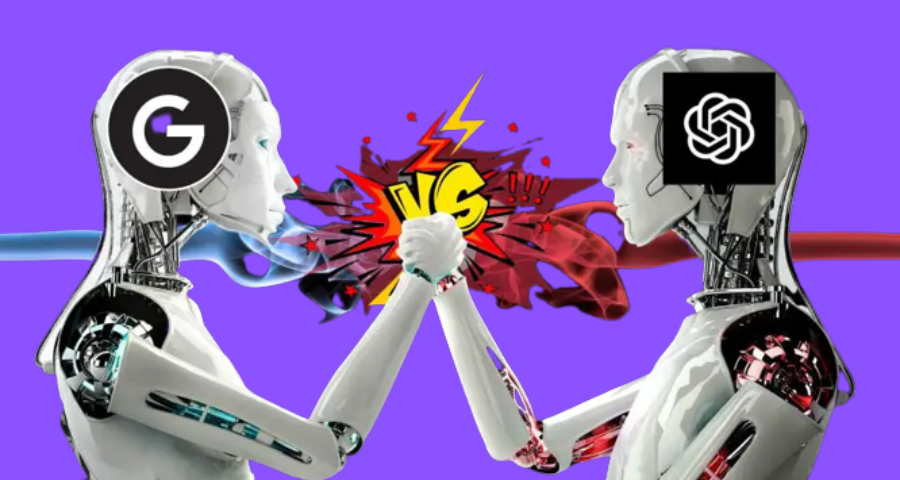In the ever-evolving landscape of artificial intelligence, two prominent players have captured the imagination of both tech enthusiasts and casual users alike – OpenAI’s ChatGPT and Google’s BARD AI. These cutting-edge language models have taken human-computer interaction to new heights, transforming the way we communicate and engage with technology. In this comprehensive guide, we’ll delve into the key differences between ChatGPT vs. Google BARD AI, shedding light on their unique features, capabilities, and potential impact on various industries.
Features: The Difference Between ChatGPT vs. Google Bard
| Feature | ChatGPT | Google Bard |
|---|---|---|
| Model | GPT-3.5 or GPT-4 | LaMDA |
| Parameters | 1.37 billion or 175 billion | 1.56 billion |
| Training Data | Text from the internet | Conversations, human dialogue, search data |
| Strengths | Generating text, translating languages, writing creative content | Answering questions, summarizing text, generating creative text |
| Weaknesses | Biased, inaccurate or misleading information, limitations in context handling | Slow response, occasional repetitiveness |
| Availability | Open-source, accessible to anyone | In beta, limited availability to select users |
Understanding ChatGPT
ChatGPT, developed by OpenAI, is a groundbreaking language model that leverages the power of deep learning to generate human-like text responses. Trained on a diverse range of internet text, ChatGPT is designed to engage in natural conversations, making it an invaluable tool for customer support, content generation, and creative writing.
Architecture and Training:
ChatGPT is based on the GPT (Generative Pre-trained Transformer) architecture. It employs a transformer model with multiple layers of attention mechanisms to understand context and generate coherent responses. The model is trained through a two-step process: pre-training and fine-tuning. During pre-training, it learns from vast amounts of text data, while fine-tuning involves refining the model on specific tasks using human feedback.
Use Cases:
ChatGPT is widely employed for various applications, including content drafting, brainstorming ideas, answering questions, and offering recommendations. Its ability to mimic human-like conversations has made it a popular choice for businesses seeking to automate customer interactions and streamline support services.
Capabilities and Limitations:
While ChatGPT excels at generating creative text and engaging in fluid conversations, it can sometimes produce inaccurate or nonsensical responses. Additionally, it may not always provide contextually appropriate answers, and there have been instances of biased outputs.
Understanding Google BARD AI
Google’s BARD (Bidirectional Encoder Representations from Transformers) AI is another breakthrough in the realm of natural language processing. Built on the transformer architecture, BARD AI showcases impressive language understanding and generation capabilities, pushing the boundaries of AI-driven communication.
Bidirectional Approach:
BARD AI is designed with a bidirectional approach, allowing it to consider context from both preceding and succeeding words in a sentence. This unique feature enhances its comprehension of nuanced language patterns and relationships.
Contextual Understanding:
BARD AI is lauded for its ability to grasp context more effectively, leading to improved text completion and contextual relevance in generated responses. This contextual understanding contributes to more coherent and accurate interactions.
Applications:
Google BARD AI finds applications in various domains, including language translation, text summarization, and content generation. Its advanced language capabilities make it a valuable asset for tasks requiring nuanced language manipulation.
Comparative Analysis
Language Comprehension:
Both ChatGPT and Google BARD AI demonstrate remarkable language comprehension abilities, but BARD AI’s bidirectional approach gives it a slight edge in understanding intricate contextual cues, leading to more accurate responses.
Response Coherence:
BARD AI’s bidirectional architecture also contributes to its superior coherence in generated text. While ChatGPT can sometimes produce coherent responses, BARD AI’s bidirectional analysis enhances the overall flow and logical structure of the text.
Contextual Relevance:
BARD AI’s contextual understanding ensures that responses align more closely with the given context, reducing instances of off-topic or irrelevant answers. ChatGPT, on the other hand, may occasionally provide contextually inappropriate responses
Conversational Engagement:
ChatGPT’s conversational capabilities are well-known, but BARD AI’s bidirectional context comprehension contributes to more engaging and contextually rich conversations.
Limitations and Bias:
Both models face challenges related to bias and accuracy. OpenAI has been working to mitigate bias in ChatGPT’s responses, while Google has made efforts to address similar concerns with BARD AI.
Potential Impact and Future Prospects
The divergence in architectural choices between ChatGPT and Google BARD AI brings forth intriguing possibilities for the future of AI-driven communication. As both models continue to evolve, it is likely that they will learn from each other’s strengths, leading to even more advanced language models with enhanced contextual understanding, reduced biases, and improved text generation capabilities.
Industries such as customer service, content creation, and language translation are poised to benefit significantly from these advancements. Businesses can harness the power of these AI models to streamline operations, enhance customer experiences, and drive innovation.
Also Read: TOP TECH NEWS TODAY: INDIA RISES AS 2ND LARGEST MOBILE MAKER, IPHONE SE 4 WITH NEW FEATURE USB-C
Conclusion
In the realm of AI-driven language models, both ChatGPT and Google BARD AI stand as remarkable achievements, each with its own set of strengths and unique characteristics. ChatGPT’s conversational prowess and versatility make it a valuable tool for a wide range of applications, while Google BARD AI’s bidirectional architecture lends itself to enhanced language comprehension and contextual relevance. As AI technology continues to advance, the boundaries between these models may blur, leading to more sophisticated and capable language models that redefine the way we interact with machines. Regardless of the path ahead, one thing is clear: AI-driven language models are reshaping the future of communication and human-computer interaction, opening doors to unprecedented possibilities in various sectors of our society.
